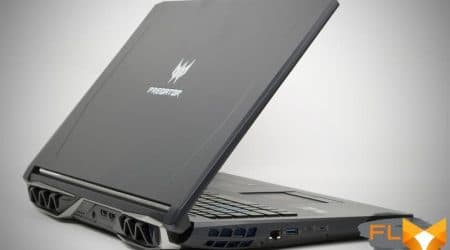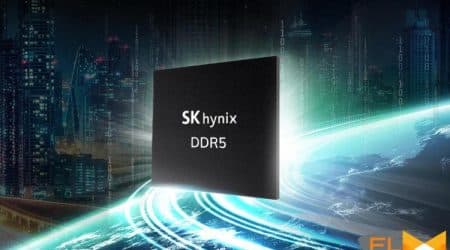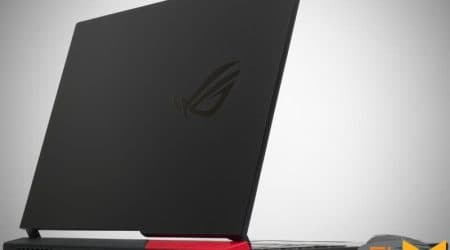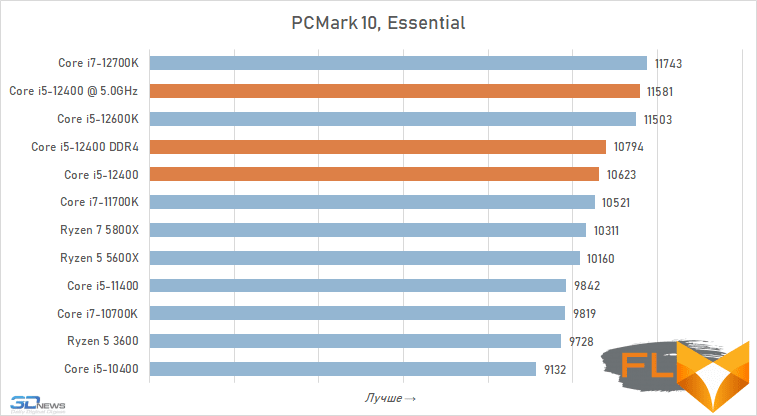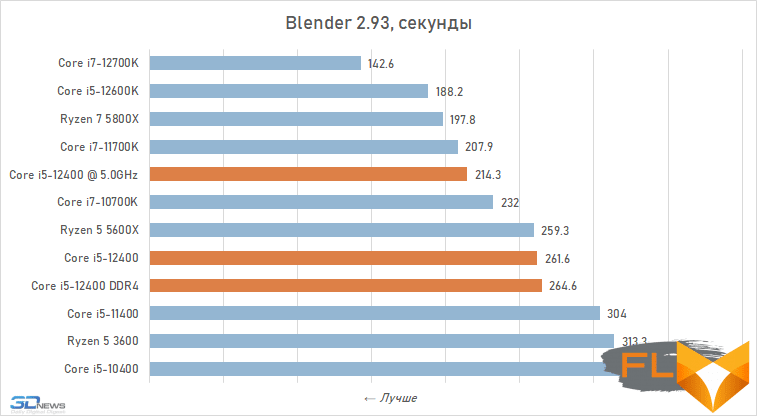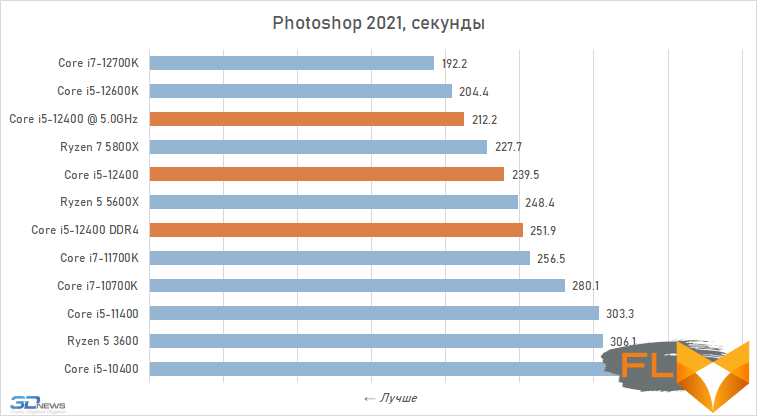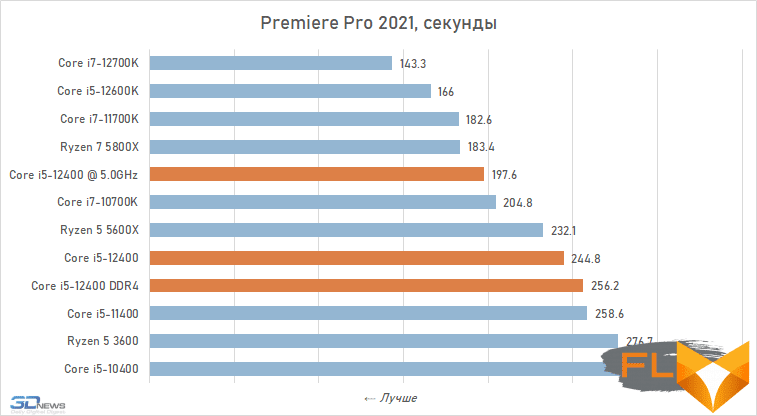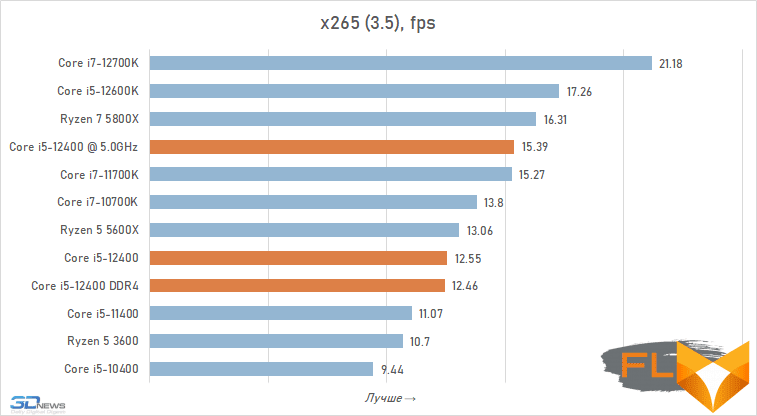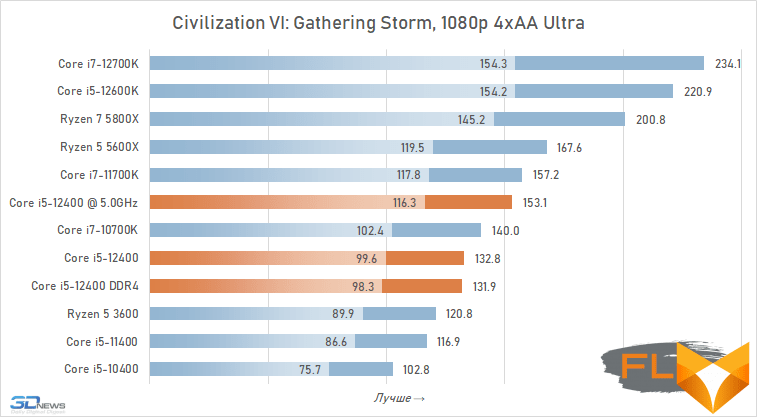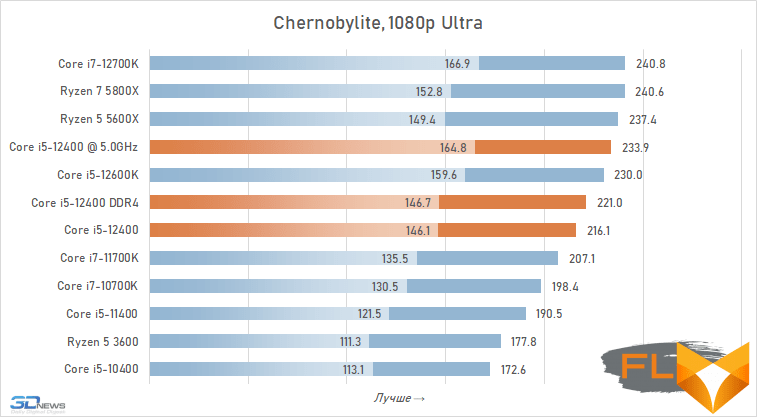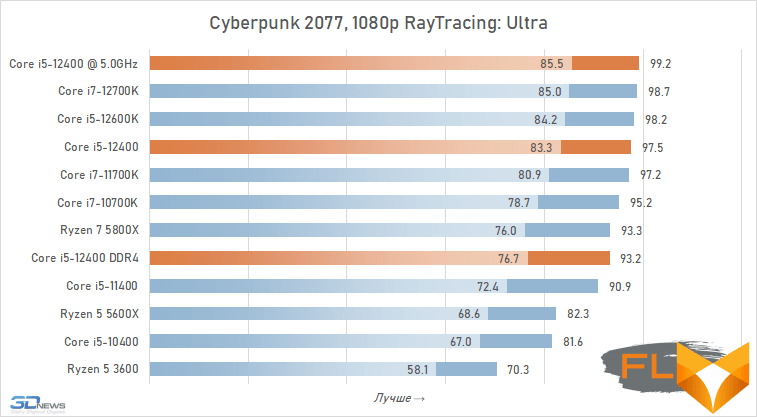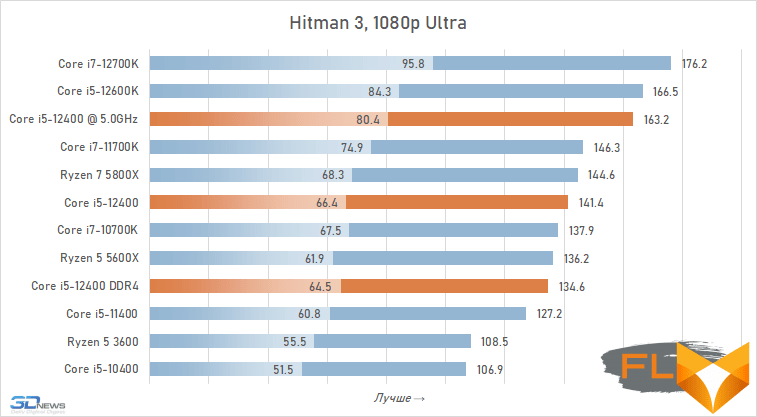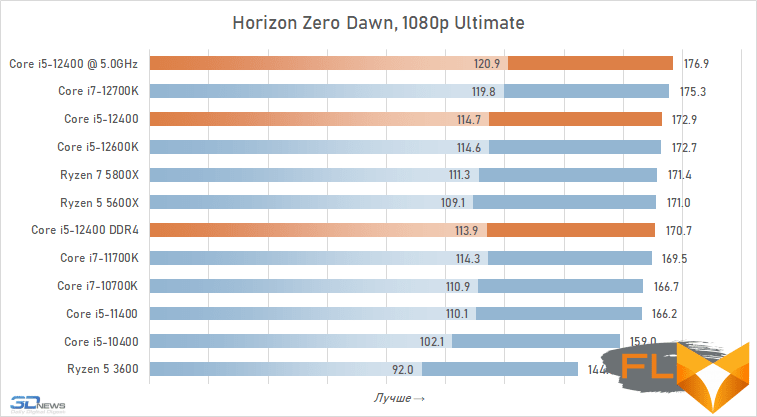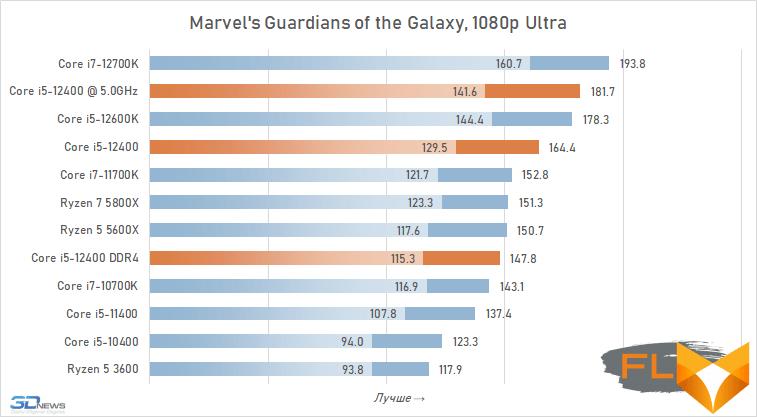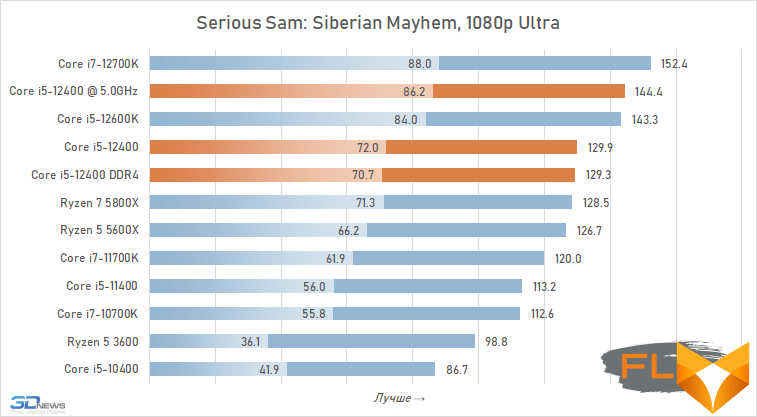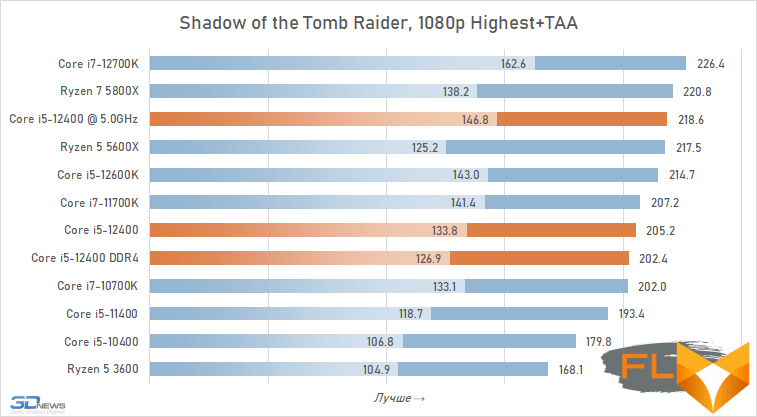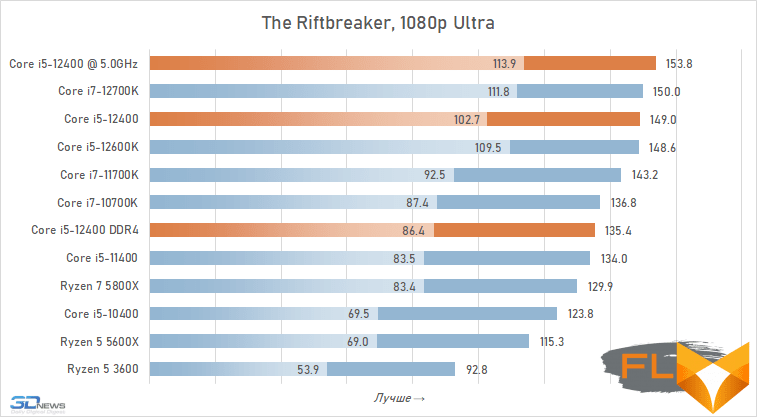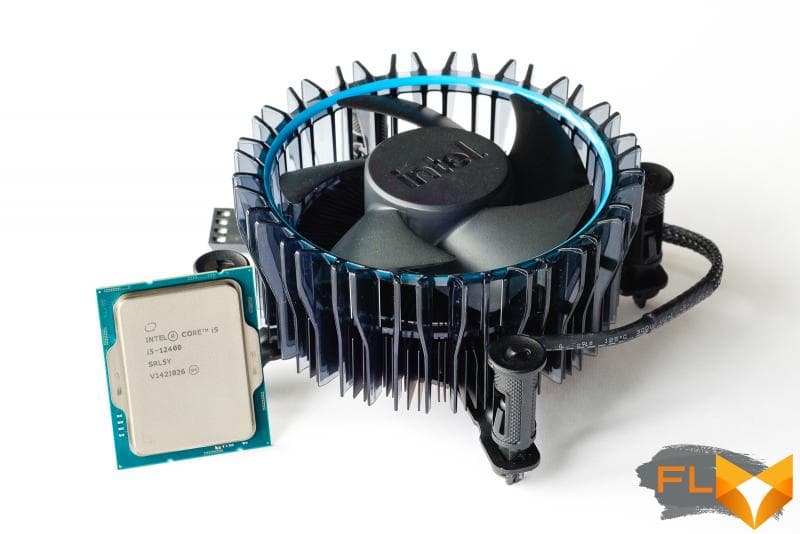


Most recently, a detailed review of the older Core i5 of the Alder Lake generation was published on our website, as a result of which it received a very flattering review. The fact is that the Core i5-12600K with a price of less than $300 not only turned out to be more powerful than all the eight-cores available on the market, including the flagships of the previous generation, but also surpassed any Ryzen brand CPUs in games. Such a brilliant performance of the Core i5-12600K immediately gave rise to a completely natural question: what are other representatives of the updated Core i5 series capable of? Previously, the most affordable representatives of this series were the most popular among the processors of this series: Core i5-9400, i5-10400, i5-11400 – they offered almost the same level of performance as their more expensive classmates, but they cost noticeably cheaper. Alder Lake also has such an inexpensive mid-range processor – Core i5-12400, and its price is one and a half times lower than that of the Core i5-12600K! But whether he is able to repeat the success of his older brother, it will not be possible to immediately say.
Observing a noticeable bias in user interest towards the younger processors of the Core i5 series, Intel has taken certain steps to make the Core i5-12600K look more attractive against the background of the Core i5-12400. As a result, a noticeable gap has formed between the characteristics of these models. While the Core i5-12600K is a 10-core CPU clocked at 3.7-4.9 GHz, the Core i5-12400 is just a 6-core CPU rated at 2.5-4.4 GHz. Therefore, in this case, the almost hundred-dollar difference in their price seems to be not only the fruit of the work of marketers and the result of the overclocker status of the Core i5-12600K – the older Alder Lake in the Core i5 series is objectively more powerful.
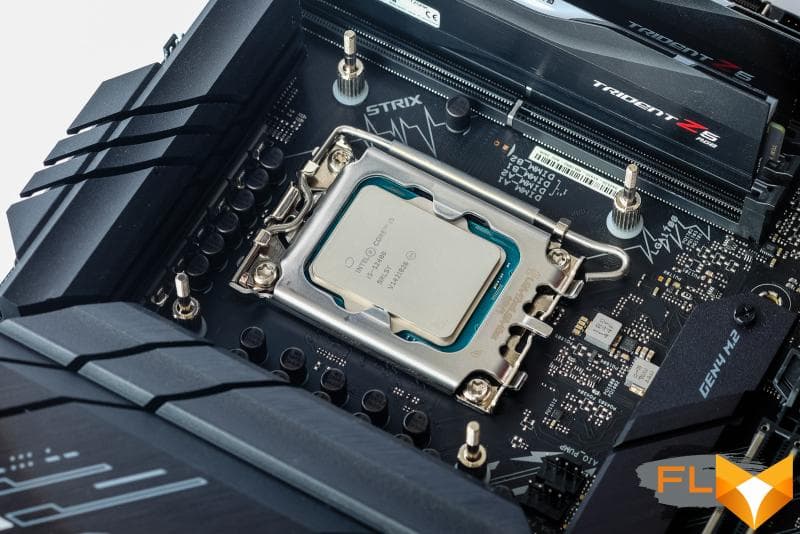
However, you should not take everything that has been said as if we began to dissuade from the acquisition of the Core i5-12400 from the first lines. This is also quite a worthy representative of the Alder Lake family, but with the Core i5-12600K it performs in different leagues. The Core i5-12400 can’t be compared to octa-core processors: rather, Intel’s calculation is that the Core i5-12400 should be the best offer among processors with six processing cores. Moreover, thanks to the official price set at $192, the Core i5-12400 even without any tests looks more attractive than any competitor’s offers. Since with the release of the Ryzen 5000 family, AMD has set the lower price bar for its current processors at $ 300, it turned out that the Core i5-12400 is simply the only modern six-core processor that can be purchased at the moment for about two hundred dollars.
And even if we are not talking about North American prices that are far from us, which repeat the recommendations of manufacturers, but about the situation in the domestic market, then the Core i5-12400 on it is significantly cheaper than the younger carrier of the AMD Zen 3 microarchitecture. In fact, AMD is trying to oppose the modern six-core Intel Ryzen 5 3600 from three years ago, which is morally obsolete even at the time of the appearance of Rocket Lake, not to mention the current situation.
In addition, the Core i5-12400 unexpectedly revealed hidden advantages. It turned out that, despite the locked multiplier, it can be overclocked to frequencies of the order of 5.0 GHz and even higher, which immediately spurred interest in this inexpensive CPU. Intel has not had such inexpensive processors with additional frequency potential since the Skylake 6000 series.
Thus, in the face of the Core i5-12400, we got a six-core CPU with an advanced microarchitecture, an affordable price and an interesting set of features for enthusiasts. Even without any testing, it is clear that in its price category it is the leader in performance – this conclusion directly follows from the results that were obtained earlier in the tests of its older brothers (Core i9-12900K, Core i7-12700K and Core i5- 12600K). But the question of how the Core i5-12400 compares to higher-end offerings remains. And in this review, we will try to find out if the younger six-core Alder Lake generation outperforms the previously released eight-core solutions from AMD and Intel, and whether it can be overclocked to such an extent that it reaches the performance of a ten-core Core i5-12600K.
⇡#More about Core i5-12400
The story about the features of the Core i5-12400 will not be too long. This is a six-core processor similar to the Core i5-10400 and Core i5-11400, which uses computing cores with the progressive Golden Cove microarchitecture – a follower of Cypress Cove. In other words, although the Core i5-12400 belongs to the Alder Lake family, it is built according to the classical canons: it has only productive cores, but there are no hybrids and Thread Director technologies. Thus, the younger new generation Core i5 is excellent
suitable for those users who do not want to switch to Windows 11 or are simply wary of new technologies.
At the same time, the Core i5-12400 still looks much more progressive than LGA1200 processors of the same class. Its Golden Cove cores offer significantly better performance-to-weight ratios than previous generations of Intel cores, plus it’s geared towards the new LGA1700 platform, which supports DDR5 memory and higher bandwidth PCIe 5.0. In addition, the amount of third-level cache in the Core i5-12400 is one and a half times more than in the Core i5-10400 and Core i5-11400 – 18 versus 12 MB.
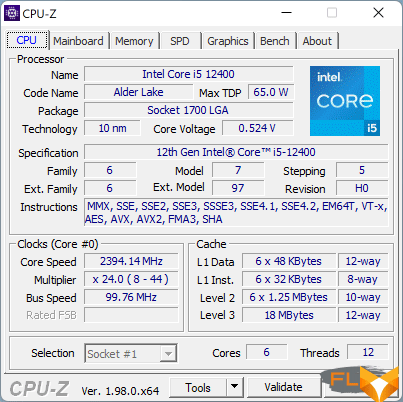
Processors of the Alder Lake generation are manufactured using the modern Intel 7 process technology, but, as we have repeatedly seen, this has almost no effect on their frequency potential. For example, for the Core i5-12400, the operating frequency range is from 2.5 to 4.4 GHz, and its upper limit is almost the same as it was for the Core i5-11400 and Core i5-10400. At the same time, the maximum frequency of the Core i5-12400 with a load on all six cores is limited to 4.0 GHz, and this is even some rollback. For example, under full load, the Core i5-11400 holds a frequency of 4.2 GHz.
But compared to its predecessors, the Core i5-12400 is a much more economical processor. The specification for it defines a thermal package of 65 W, and the maximum power consumption is declared at around 117 W. And these are not just realistic, but in some ways even overestimated boundaries. So, during multi-threaded rendering in Blender (and this is one of the most difficult practical loads), our copy of the Core i5-12400 consumed about 74 W, and in the Prime95 stress test using AVX2 instructions, it did not go beyond 81 W. And this means that even if the nominal limits of PL1 and PL2 are activated, the six-core Alder Lake will have a frequency near the maximum values \u200b\u200ballowed by the specification.
The graph below just shows how the Core i5-12400 frequency behaves when rendering in Blender, if the processor is operating in normal mode, when PL1 = 65 W and PL2 = 117 W.
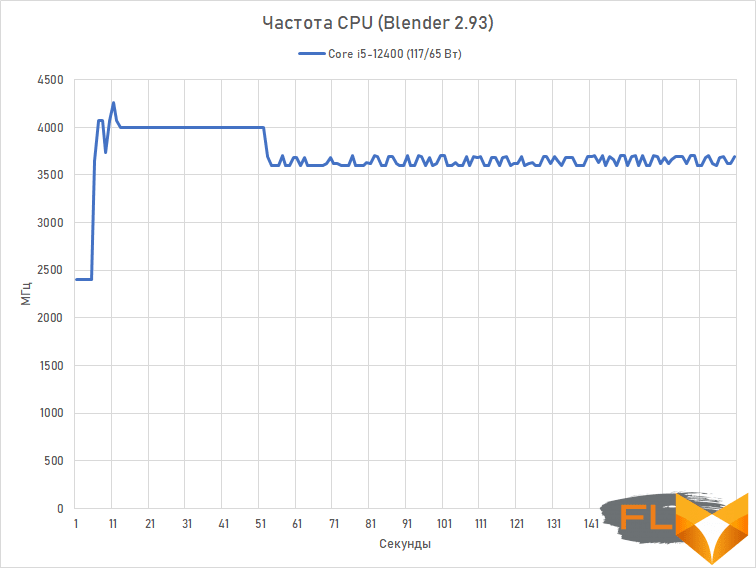
The first 45 seconds, while the PL2 limit is in effect, the frequency is kept at the maximum mark of 4.0 GHz without any problems, then, when the 65-watt PL1 consumption limit is turned on, the frequency is cut off, but not too significantly – up to 3.6-3.7 GHz.
However, there is no point in using the processor in this mode. Disabling PL1/PL2 limits increases power consumption and heat very little: even budget LGA1700 motherboards and simple cooling systems can handle the Core i5-12400. For example, the cooler that Intel puts into boxes with this processor is quite efficient enough to provide a favorable temperature regime for the junior six-core processor even if the PL1/PL2 limits are cancelled. By the way, in the 12th generation of Core processors, Intel replaced the complete cooling systems, and the Core i5-12400 comes not with the usual DHA-X cooler, but with a completely new Laminar RM1, which has become larger, heavier and more efficient. This cooler looks like this.
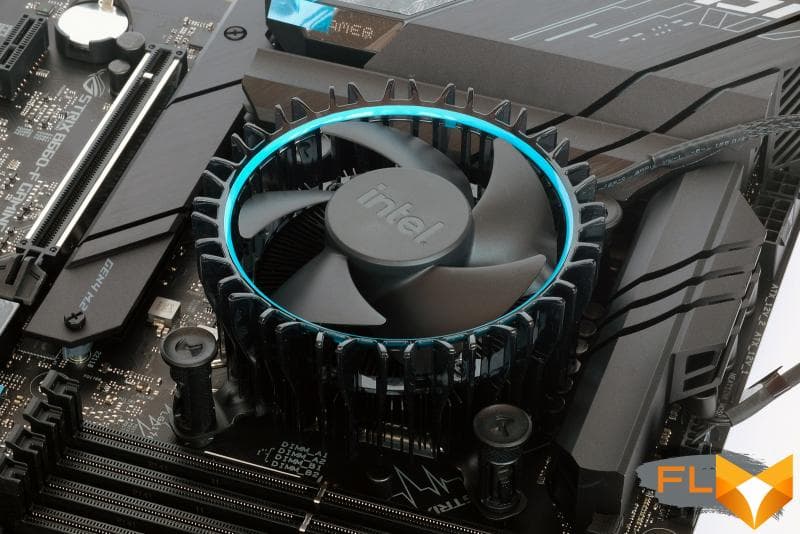
Its effectiveness when used with the Core i5-12400 can be estimated from the processor temperature graph, which is observed when rendering in Blender with both activated and deactivated PL1/PL2 limits.

It can be clearly seen that, if the consumption limits of the Core i5-12400 are completely canceled, the Laminar RM1 cooler manages to keep the processor temperature within 90 degrees even at peak multi-threaded load. In the same case, when the consumption is limited to the 65-watt limit, the processor heats up no higher than 80 degrees. In other words, the six-core Core i5-12400 is an economical and cold processor, which has not been in Intel’s arsenal for a very long time.
To illustrate this even more clearly, another pair of graphs compares the power consumption of the Core i5-12400 with the power consumption of other six-core processors – Core i5-11400 and Ryzen 5 5600X – in the game Horizon Zero Dawn and when rendering in Blender.
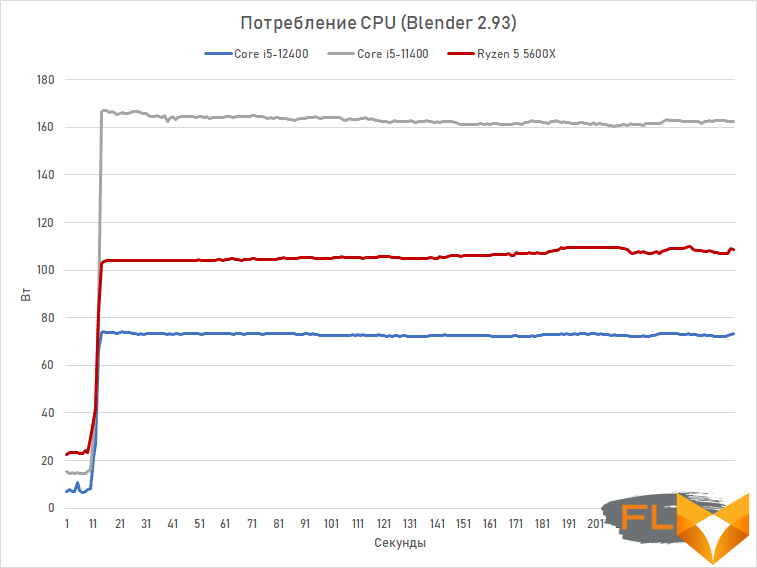
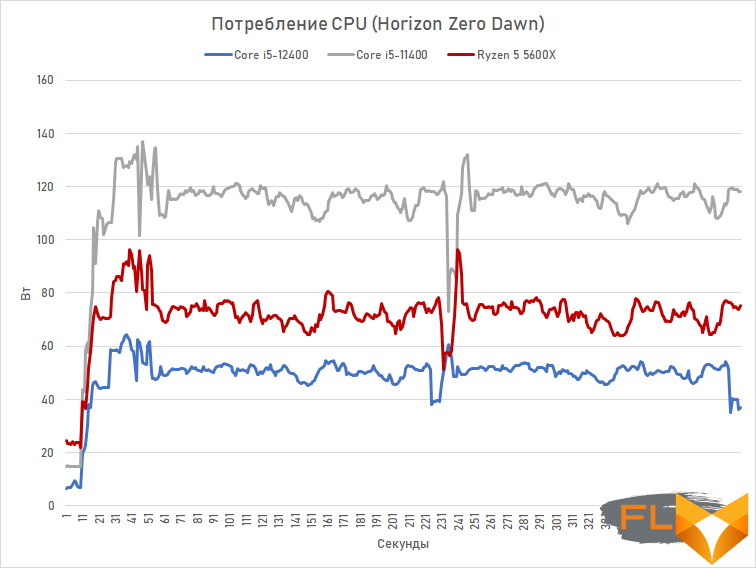
We have already made a similar comparison, and the Core i5-12400 in it noticeably outperformed both the representative of the Rocket Lake family and Zen 3 in terms of energy efficiency. And now this gap has become even stronger. A comparison with the Core i5-11400 hardly makes any sense at all – the new generation six-core is fundamentally more economical. But even when comparing the consumption of the Core i5-12400 and the Ryzen 5 5600X, the six-core Alder Lake outperforms its rival by about one and a half times both in rendering and in gaming load.
As for the slightly lower consumption of the Core i5-12400 compared to previous measurements, it is due to the fact that in this case, the tests use a different instance of the processor, built on an H0 stepping chip, and not C0, as last time. In practical terms, this means that we are now testing a processor on a small die, which initially has only six P-cores, and not on a partially deactivated Alder Lake full die with eight P- and eight E-cores. Apparently, similar versions of the Core i5-12400 stepping H0 have the best energy efficiency. Recognizing such processors in the store is quite simple – they are marked with S-Spec identifiers (which are printed both on the processor cover and on the label on the box) SRL5Y or SRL5Z. However, the difference between the versions of the Core i5-12400 C0 stepping is not so great – in our experience, at maximum load they consume only 10% more.

Concluding acquaintance with the characteristics of the Core i5-12400, you need to pay attention to one more of its features. It comes with UHD Graphics 730 instead of UHD Graphics 770 like the more expensive Alder Lake variants. And this is a weaker GPU in terms of 3D capabilities, the number of execution units of which has been reduced from 32 to 24. However, the graphics built into Intel desktop processors do not differ in high 3D performance in any case, and such a reduction in its power is unlikely to be much some serious disadvantage. Moreover, in terms of multimedia capabilities, the UHD Graphics 730 and UHD Graphics 770 are identical.
In the table below, you can evaluate how the Core i5-12400 is ultimately integrated into the overall Alder Lake lineup, and at the same time notice that along with it there is also a Core i5-12400F model without a graphics core, which costs $ 25 less than a full-fledged option.
| Number of cores | Number of threads | Frequency P-cores, GHz |
Frequency E-cores, GHz |
L3 cache, MB | Graphics | Basic TDP, W |
Turbo TDP, W |
Price | |
|---|---|---|---|---|---|---|---|---|---|
| i9-12900K | 8P + 8E | 24 | 3.2-5.2 | 2.4-3.9 | 30 | UHD 770 | 125 | 241 | $589 |
| i9-12900KF | 8P + 8E | 24 | 3.2-5.2 | 2.4-3.9 | 30 | No | 125 | 241 | $564 |
| i9-12900 | 8P + 8E | 24 | 2.4-5.1 | 1.8-3.8 | 30 | UHD 770 | 65 | 202 | $489 |
| i9-12900F | 8P + 8E | 24 | 2.4-5.1 | 1.8-3.8 | 30 | No | 65 | 202 | $464 |
| i7-12700K | 8P + 4E | 20 | 3.6-5.0 | 2.7-3.8 | 25 | UHD 770 | 125 | 190 | $409 |
| i7-12700KF | 8P + 4E | 20 | 3.6-5.0 | 2.7-3.8 | 25 | No | 125 | 190 | $384 |
| i7-12700 | 8P + 4E | 20 | 2.1-4.9 | 1.6-3.6 | 25 | UHD 770 | 65 | 180 | $339 |
| i7-12700F | 8P + 4E | 20 | 2.1-4.9 | 1.6-3.6 | 25 | UHD 770 | 65 | 180 | $314 |
| i5-12600K | 6P + 4E | 16 | 3.7-4.9 | 2.8-3.6 | 20 | UHD 770 | 125 | 150 | $289 |
| i5-12600KF | 6P + 4E | 16 | 3.7-4.9 | 2.8-3.6 | 20 | No | 125 | 150 | $264 |
| i5-12600 | 6P | 12 | 3.3-4.8 | – | 18 | UHD 770 | 65 | 117 | $223 |
| i5-12500 | 6P | 12 | 3.0-4.6 | – | 18 | UHD 770 | 65 | 117 | $202 |
| i5-12400 | 6P | 12 | 2.5-4.4 | – | 18 | UHD 730 | 65 | 117 | $192 |
| i5-12400F | 6P | 12 | 2.5-4.4 | – | 18 | No | 65 | 117 | $167 |
| i3-12300 | 4P | 8 | 3,5-4,4 | – | 12 | UHD 730 | 60 | 89 | $143 |
| i3-12100 | 4P | 8 | 3,3-4,3 | – | 12 | UHD 730 | 60 | 89 | $122 |
| i3-12100F | 4P | 8 | 3,3-4,3 | – | 12 | No | 60 | 89 | $97 |
⇡#Overclocking
Another advantage of Alder Lake processors is the increased overclocking capabilities. Namely, among the CPUs for the LGA1700 processor socket, all models can be overclocked – both with and without an unlocked multiplier. The only difference is in the approach – K-class processors have free multipliers, and thanks to this, their frequencies can be easily changed at the request of the user (on motherboards based on the Intel Z690 logic set). The same processors with a limited multiplier, such as the Core i5-12400 under consideration, can be overclocked by the clock generator frequency – this only requires a special motherboard, which includes an additional frequency generator.
The processor frequency is defined as the product of two values - the multiplier and the BCLK base frequency, which is 100 MHz by default. Theoretically, increasing the CPU frequency above the nominal value is possible by changing any of the factors. However, in practice, Intel processors of the latest generations could be overclocked only by increasing the multiplier. Increasing the BCLK frequency was impossible, since it was involved in shaping not only the processor frequency, but also other frequencies in the system, for example, for PCIe and DMI buses, which remain stable only in a very limited range of values.
However, with the advent of the LGA1700 platform, the situation has changed somewhat: Intel has allowed motherboard manufacturers to use two independent base clock generators in their systems: one for the frequency of computing cores, integrated graphics, cache and memory, and the other for PCIe and DMI buses. And this immediately changed the situation radically. Processors with multipliers that are not subject to increase have a chance to set overclocking records along with K-series processors. All you need is a motherboard with an additional BCLK frequency generator.
True, installing a second clock generator on the board increases its cost, so the majority of LGA1700 motherboards, unfortunately, rely on a single BCLK generator built into the processor. Boards designed in this way are, of course, not suitable for overclocking processors with a locked multiplier. But at the same time, there is another, relatively small group of boards, on which manufacturers, in addition to the processor board, install a second, external frequency generator. On such boards, the in-processor generator is switched to generate only the frequencies of the PCIe and DMI buses, and the external generator generates the frequency for the in-processor components. And this scheme allows you to decouple BCLK from PCIe and DMI frequencies and opens up scope for overclocking any Alder Lake in a very wide range.
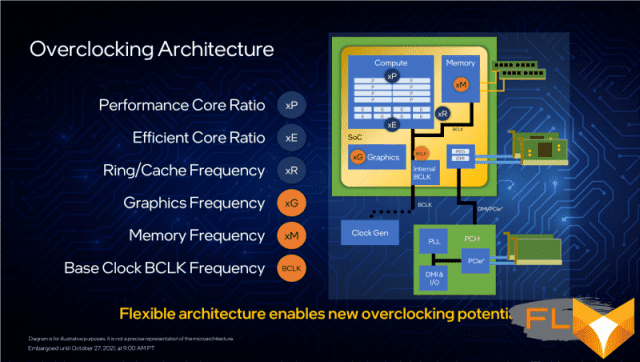
The list of boards that have an additional frequency generator and are capable of overclocking Alder Lake processors with the BCLK bus currently includes 11 items: ASUS Maximus Z690 Formula, ASUSMaximus Z690 Extreme, ASUSMaximus Z690 Hero, ASUSMaximus Z690 Apex, ASUSStrix B660-G Gaming, ASUSStrix B660-F Gaming, ASRock Z690 Aqua OC, Gigabyte Aorus Tachyon, MSI Z690I Unify, MSI Z690 Unify X and MSI Z690 Ace. As you can see, both Z690 and B660 boards are listed here – nothing depends on the chipset, it’s all about the additional clock generator.
Therefore, for experiments on overclocking the Core i5-12400, we chose a board based on the B660 – ASUSROG Strix B660-F Gaming WiFi. Firstly, it is one of the most affordable in the above list and is best combined with a mid-range processor. Secondly, there is simply no point in using the Z690 chipset in tandem with a “non-K” processor. In the case of the Core i5-12400, you do not need to control the CPU multiplier, and B660-based motherboards also have all the other necessary features for overclocking memory and L3 cache.
The overclocking algorithm for the Core i5-12400 is extremely simple. First of all, the processor needs to fix the maximum possible multiplier of 40x for it (with a load on all cores), and then you can start increasing the BCLK frequency. In the BIOS of the ASUSROG Strix B660-F Gaming WiFi motherboard, among the processor settings for this, there is a special BCLK Frequency variable – increasing it above the nominal 100 MHz will just lead to the CPU running at higher frequencies. Since the used board has a separate generator for the frequency of capricious PCIe and DMI buses, a significant change in the BCLK frequency will not lead to inoperability or instability of the system.
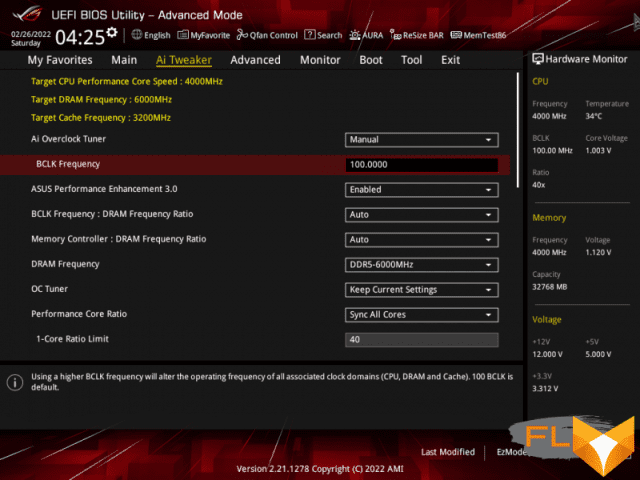
However, it should be taken into account that not only the frequency of processor cores depends on BCLK, but also the frequency of its L3 cache, as well as the memory frequency. Therefore, when increasing the BCLK frequency, one should not forget to reduce the DRAM and cache multipliers to realistic values so that their final frequencies do not go beyond the capabilities of the respective nodes. Otherwise, the overclocking procedure is the same as usual, and for its greater effectiveness, you can resort to increasing the CPU supply voltage.
In the end, the test Core i5-12400, by increasing the BCLK frequency to 125 MHz, easily overclocked to 5.0 GHz – 25% above nominal. The voltage at which the processor worked stably at this frequency was 1.25 V. Along the way, to counteract the voltage drop with increasing current, the Load-Line Calibration function was switched to Level 4 (out of seven). The multiplier for the L3 cache with this overclocking was set to 32x – this gave it a final frequency of 4.0 GHz.
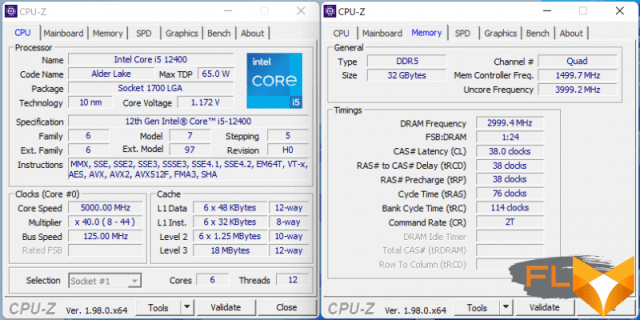
In this mode, the processor passed stress tests without any problems, including in Prime95 with AVX2 instructions. At the same time, the Core i5-12400 could be tested for stability without vector instructions at a frequency of 5.2 GHz at a voltage of 1.35 V. However, an AVX2 load with these settings immediately led to either overheating or CPU errors. In overclocker processors with an unlocked multiplier, dynamic multiplier reduction when AVX blocks are activated helps in this situation, but this feature is not available for non-overclocker processors like the Core i5-12400. Therefore, the only way to achieve stable performance of the Core i5-12400 at 5.2 GHz is to turn off AVX / AVX2 support completely – the corresponding option is in the BIOS of motherboards, and this option may seem quite acceptable to someone.
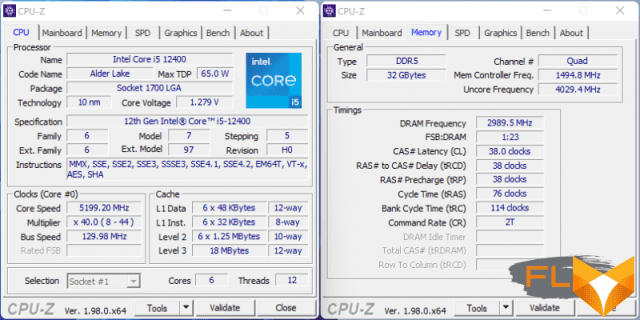
If you’ve been following what’s going on with PCs for quite some time, you may remember that the last time the ability to overclock locked Intel processors was opened up in 2015, when representatives of the Skylake family were in use. And then the increase in the frequency of the BCLK bus caused rather unpleasant side effects – the inoperability of hardware monitoring, the disabling of the graphics core built into the processor, and a significant decrease in the performance of AVX/AVX2 operations. When overclocking the BCLK frequency of representatives of the Alder Lake family, no such troubles are observed, except perhaps for the distortion of the CPU consumption readings in the monitoring utilities. Although programs like HWINFO64 report that the Core i5-12400 overclocked to 5.0-5.2 GHz consumes about 100-120 watts, in reality this is not the case. Its real consumption at 5.0 GHz is 150-160 W when loaded with multi-threaded rendering in Blender.
⇡#ASUS ROG Strix B660-F Gaming WiFi Motherboard
The motherboard, which was able to overclock the Core i5-12400 and thus became a full participant in this test, certainly deserves a separate story. Moreover, we are talking about a far from ordinary product: in fact, ASUS ROG Strix B660-F Gaming WiFi is the most advanced platform that can only be built on the basis of the “average” Intel B660 chipset.
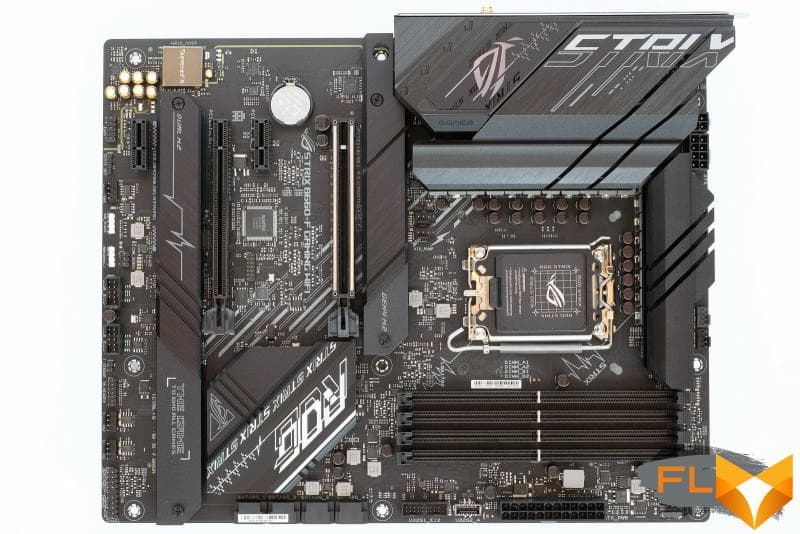
All boards capable of overclocking blocked Alder Lake are quite expensive platforms. Most of them are based on the older Z690 system logic, and all such boards are designed for DDR5 SDRAM. ASUS ROG Strix B660-F Gaming WiFi among them looks a little more democratic, but it also costs more than $350. You should not be surprised at such a price, this is the oldest solution among all ASUS boards based on the B660 chipset, and it seems to have been created with a clear intention to make a board with flagship capabilities for those who for some reason prefer processors without the letter K in the name.
However, in the end, the ROG Strix B660-F Gaming WiFi turned out to be such that it’s not a shame to put the flagship Alder Lake into it. Overclocking older processors that have already been brought to the maximum frequencies out of the box usually does not give a noticeable performance boost, so using them in powerful motherboards based on the Intel B660 is a completely acceptable approach. The main thing is that such boards should have a good “safety margin” in terms of power supply and allow flexible configuration of the memory subsystem. ROG Strix B660-F Gaming WiFi has no problems with either – it is quite comparable in terms of equipment to representatives of the ROG Strix series using the Intel Z690 chipset. In addition, the impossibility of overclocking the CPU with a multiplier on the ROG Strix B660-F Gaming WiFi fully compensates for the overclocking with the BCLK frequency supported by this board.

To feel the high level of ASUS ROG Strix B660-F Gaming WiFi, just look at its power converter. The voltage of 12 V is supplied to it from two (eight-pin and four-pin) power connectors, and the whole circuit is closed by two massive radiators with a developed profile.
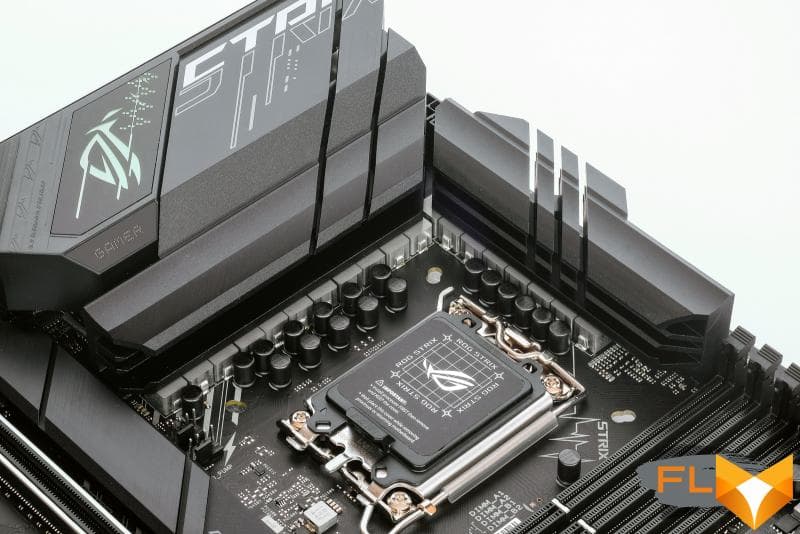
Hidden under the heatsinks is an ASP2100 PWM controller that drives 8+1 power converter channels that house 55-amp Alpha & Omega B6N0 – two in each channel. This means that at the peak such a circuit can deliver up to 880 A, and in terms of power it is similar to the power converter installed, for example, on the ROG Strix Z690-G Gaming WiFi. This gives confidence that the ROG Strix B660-F Gaming WiFi will certainly not have problems with the flagship Alder Lake, even if they do not work in normal mode, but with overclocking. That is why when you connect the power supply to both 12-volt connectors, the board by default removes all power consumption restrictions PL1 and PL2 from the processor.

Just in case, we checked out how the ROG Strix B660-F Gaming WiFi Power Converter handles the Core i9-12900K with the consumption limits removed in the Prime95 stress test with AVX2 instructions. In it, the processor consumes about 310 watts, but the VRM on the board does not show the slightest sign of overheating even after a half-hour test run. The maximum temperature of the power circuit, according to hardware monitoring, eventually reached only 74 degrees, and the radiators heated up to a maximum of 60 degrees.

In other words, the power scheme on the ROG Strix B660-F Gaming WiFi is made to last. The same can be said for memory support. The board is designed to work with DDR5 SDRAM, and we are talking about the possibility of using overclocker modules up to DDR5-6000 – and there really are no problems with them, as we saw for ourselves. At the same time, the BIOS has all the necessary options for configuring both timings and memory voltages – in this respect, ROG Strix B660-F Gaming WiFi is absolutely not inferior to solutions based on the Intel Z690 logic set.
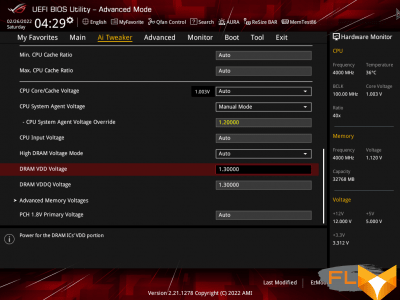 |
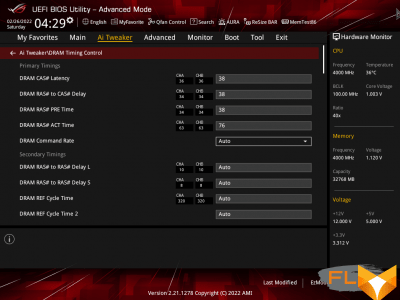 |
It is difficult to make any claims about equipping the motherboard in question with expansion slots. A mechanically reinforced PCIe 5.0 x16 slot is provided for installing a video card. In addition to it, there is another PCIe x16 slot, to which four PCIe 3.0 lanes from the chipset are connected. The board also has a pair of PCIe 3.0 x1 slots.
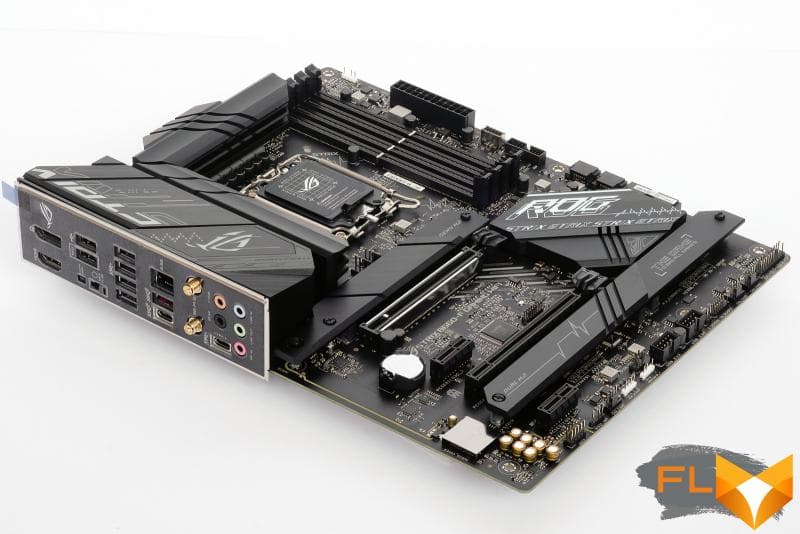
Even more impressive is the range of M.2 slots for installing NVMe SSDs: there are three of them on the ROG Strix B660-F Gaming WiFi. One of them is connected to the CPU and supports PCIe 4.0 drives, and two more are chipset-based: one with PCIe 4.0 support and the second with PCIe 3.0 support. All three slots are equipped with heatsinks, allowing you to use high-performance NVMe SSD models. SATA drives are not supported by M.2 slots, but they can be connected to the board’s four SATA 3 ports.
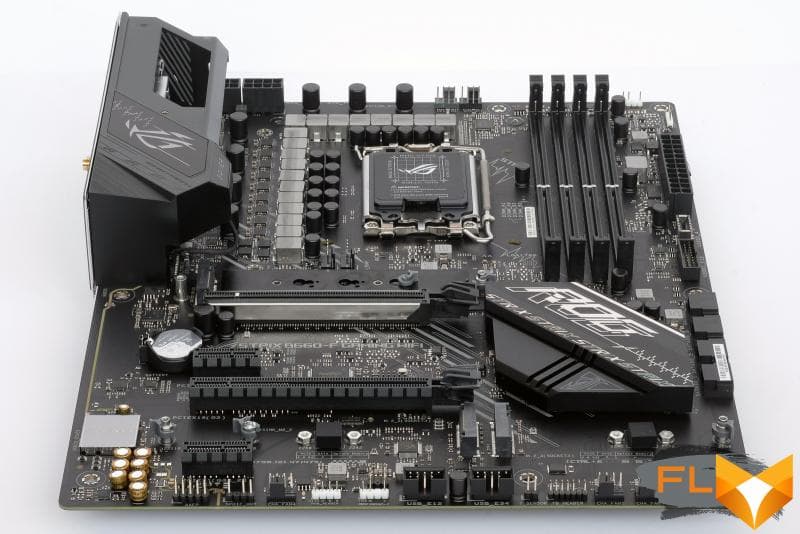
In general, the ASUS ROG Strix B660-F Gaming WiFi pays quite a lot of attention to cooling. And it’s not just the efficient heatsinks on the VRM, chipset, and M.2 slots. In addition, the board has two sets of holes for mounting processor cooling systems, allowing you to install both LGA1700 and LGA1200 coolers. But even more impressive is the number of connectors for connecting fans – there are seven of them at once.
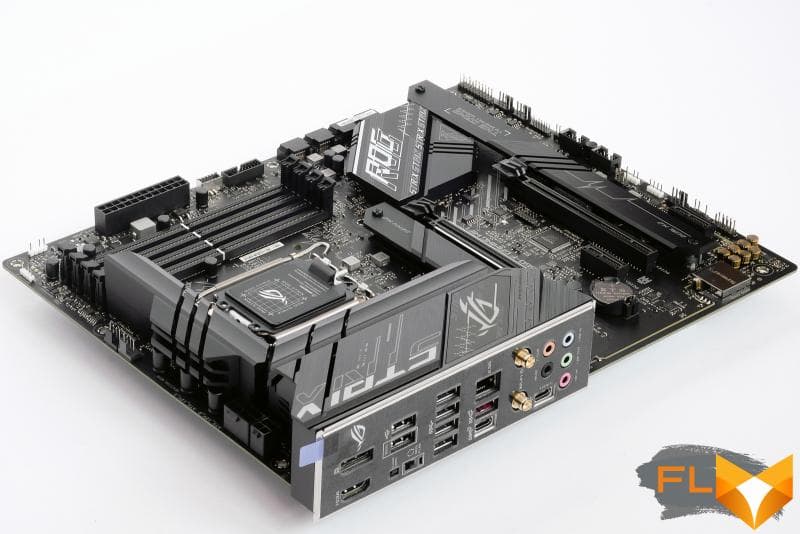
The back panel of the ASUS ROG Strix B660-F Gaming WiFi looks very atypical for a B660 motherboard – it has a surprisingly large number of connectors. Moreover, ASUS has not stinted even on the buttons for resetting the BIOS settings and updating the firmware using BIOS FlashBack technology. You can also find monitor outputs, two USB 2.0 ports, four USB 3.2 Gen 1 Type-A (5 Gb / s), one USB 3.2 Gen 1 Type-C (5 Gb / s), one USB 3.2 Gen 2 port Type-A (10 Gb / s) and another USB 3.2 Gen 2 × 2 Type-C (20 Gb / s). Networking features include a 2.5Gbps wired port powered by an Intel I225-V controller and Intel Wi-Fi 6 wireless networking (required antenna included). And the final touch is the analog audio outputs of the integrated 7.1-channel SupremeFX ALC4080 sound card with a set of proprietary ASUS technologies and an increased sampling rate up to 384 kHz.
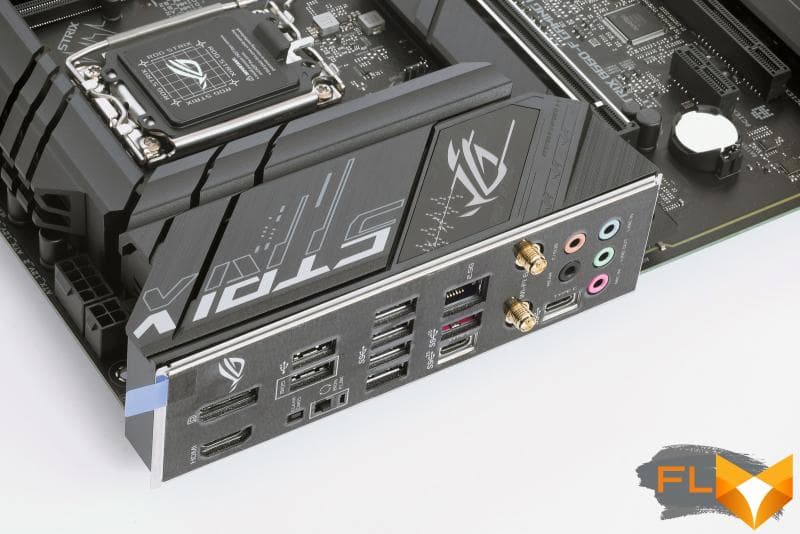
Two more USB 3.2 Gen 1 Type-A ports and one USB 3.2 Gen 2 Type-C port are provided on the board by internal connectors. A Thunderbolt 4 connector is also provided – you can connect an appropriate expansion card to it, for example, the branded ASUS ThunderboltEX 4.
Concluding the story about the board, it should be noted that ASUS did not stint on embellishments so that the ROG Strix B660-F Gaming WiFi looked no worse than other members of the ROG Strix family. There is an illuminated ROG logo in the rear panel area, in addition, four RGB strips can be connected to the board at once, three of which are addressable.
⇡#Description of the test system and testing methodology
The main rivals of the Core i5-12400 should be AMD’s six-core Ryzen 5 5600X and Ryzen 5 3600. The first is because it is the only full-fledged six-core processor of the Zen 3 family for desktop PCs, and the second is because it is close to the Core i5-12400 in price. But besides them, we also included in the testing the eight-core Ryzen 7 5800X, which in the last review was inferior in performance to the Core i5-12600K, which means it can be an equal rival for at least the Core i5-12400.
In view of the above, the test system included the following components:
- Processors:
- AMD Ryzen 7 5800X (Vermeer, 8 cores + SMT, 3.8-4.7GHz, 32MB L3);
- AMD Ryzen 5 5600X (Vermeer, 6 cores + SMT, 3.7-4.6GHz, 32MB L3);
- AMD Ryzen 5 3600 (Matisse, 6 cores + SMT, 3.6-4.2GHz, 32MB L3);
- Intel Core i7-12700K (Alder Lake, 8P+4E-cores + HT, 3.6-5.0/2.7-3.8GHz, 25MB L3);
- Intel Core i7-11700K (Rocket Lake, 8 cores + HT, 3.6-5.0 GHz, 16MB L3);
- Intel Core i7-10700K (Comet Lake, 8 cores + HT, 3.8-5.1GHz, 16MB L3);
- Intel Core i5-12600K (Alder Lake, 6P+4E-cores + HT, 3.7-4.9/2.8-3.6GHz, 20MB L3);
- Intel Core i5-12400 (Alder Lake, 6P cores + HT, 2.5-4.4GHz, 18MB L3);
- Intel Core i5-11400 (Rocket Lake, 6 cores + HT, 2.6-4.4 GHz, 12MB L3);
- Intel Core i5-10400 (Comet Lake, 6 cores + HT, 2.9-4.3 GHz, 12MB L3).
- CPU cooler: Noctua NH-D15S.
- Motherboards:
- ASUS ROG Strix B660-F Gaming WiFi (LGA1700, Intel B660, DDR5 SDRAM).
- ASUS ROG Strix X570-E Gaming WiFi (Socket AM4, AMD X570);
- ASUS ROG Strix Z590-A Gaming WiFi (LGA1200, Intel Z590);
- ASUS ROG Strix Z690-A Gaming WiFi D4 (LGA1700, Intel Z690, DDR4 SDRAM);
- ASUS ROG Strix Z690-F Gaming WiFi (LGA1700, Intel Z690, DDR5 SDRAM).
- Memory:
- 2x16GB DDR4-3600 SDRAM, 16-18-18-38 (Crucial Ballistix RGB BL2K16G36C16U4BL);
- 2x16GB DDR5-6000 SDRAM, 38-38-38-76 (G.Skill Trident Z5 RGB F5-6000U4040E16GX2-TZ5RK).
- Video Card: NVIDIA GeForce RTX 3090 Founders Edition (GA102, 1395-1695/19500MHz, 24GB GDDR6X 384-bit).
- Disk subsystem: Intel SSD 760p 2TB (SSDPEKKW020T8X1).
- Power supply: Thermaltake Toughpower DPS G RGB 1000W Titanium (80 Plus Titanium, 1000W).
All compared processors were tested with canceled artificial consumption restrictions. This means that the PPT (for AMD platform) and PL1/PL2 (for AMD platform) limits are ignored, instead the maximum possible frequencies are used in order to obtain maximum performance.
The Core i5-12400 processor was tested twice: both at nominal frequencies and when overclocked to 5.0 GHz, obtained on the ASUS ROG Strix B660-F Gaming WiFi board, by increasing the BCL frequency to 125 MHz.
The memory subsystems were configured using XMP profiles. LGA1200 and Socket AM4 processors were tested with DDR4-3600, and Alder Lake with DDR4-3600 and DDR5-6000.
Testing was performed on the Microsoft Windows 11 Pro (21H2) Build 22000.282.0 operating system with KB5005635 and KB5006746 updates installed and using the following driver set:
- AMD Chipset Driver 3.10.08.506;
- Intel Chipset Driver 10.1.18838.8284;
- Intel SerialIO Driver 30.100.2105.7;
- Intel Management Engine Interface 2124.100.0.1096;
- NVIDIA GeForce 511.23 Driver.
Description of the tools used to measure computing performance:
Comprehensive benchmarks:
- Futuremark PCMark 10 Professional Edition 2.1.2508 – testing in Essentials scenarios (typical work of the average user: launching applications, surfing the Internet, video conferencing), Productivity (office work with a word processor and spreadsheets), Digital Content Creation (creating a digital content: photo editing, non-linear video editing, rendering and visualization of 3D models).
- 3DMark Professional Edition 2.22.7336 – testing in the CPU Profile 1.1 scenario with eight active threads and at the maximum possible processor load.
Applications:
- 7-zip 21.02 – archiving speed testing. The time taken by the archiver to compress a directory with various files with a total volume of 3.1 GB is measured. Uses LZMA2 algorithm and maximum compression ratio.
- Adobe Photoshop 2021 22.4.3 – Graphics performance testing. The average execution time of the Puget Systems Adobe Photoshop CC Benchmark 18.10 test script, which simulates the typical processing of an image taken by a digital camera, is measured.
- Adobe Photoshop Lightroom Classic 10.3 – performance testing for batch processing of a series of images in RAW format. The test scenario includes post-processing and export to JPEG at a resolution of 1920 × 1080 and a maximum quality of two hundred 16-megapixel RAW images taken with a Fujifilm X-T1 digital camera.
- Adobe Premiere Pro 2021 15.4.0 – performance testing for non-linear video editing. Measures rendering time to YouTube 4K for a project containing HDV 2160p30 footage with various effects applied.
- Blender 2.93.5 – testing the speed of the final rendering in one of the popular free packages for creating three-dimensional graphics. The duration of building the final model pavillon_barcelona_v1.2 from Blender Benchmark is measured.
- Mathworks Matlab R2021b (9.11.0) – testing the speed of engineering and mathematical calculations in a popular mathematical package. A standard benchmark is used, which includes matrix and vector operations, the solution of differential and symmetric sparse linear systems of equations, as well as the construction of 2D and 3D graphs.
- Microsoft Visual Studio 2017 (15.9.40) – Compile time measurement of a large MSVC project – Blender 2.79b professional 3D package.
- Stockfish 14.1 – testing the speed of the popular chess engine. The speed of enumeration of options in the position “1q6/1r2k1p1/4pp1p/1P1b1P2/3Q4/7P/4B1P1/2R3K1 w” is measured.
- SVT-AV1 v0.8.6 – testing the speed of video transcoding to the promising AV1 format. Performance is measured using a raw 1080p@50FPS AVC video file with a bitrate of about 30 Mbps.
- Topaz Video Enhance AI v2.3.0 – performance testing in an AI-based program to improve video detail. The test uses the original video at 640×360 resolution, which is doubled using the Artemis Anti Aliasing v9 model.
- V-Ray 5.00 – Benchmark the performance of a popular rendering system using the standard V-Ray Benchmark Next application.
- x265 3.5+8 10bpp – testing the speed of video transcoding to H.265/HEVC format. To evaluate performance, we use the original 2160p@24FPS AVC video file with a bitrate of about 42 Mbps.
Games:
- Chernobylite. Resolution 1920 × 1080: Graphics Quality = Ultra.
- Civilization VI: Gathering Storm. Resolution 1920×1080: DirectX 12, MSAA=4x, Performance Impact=Ultra, Memory Impact=Ultra.
- Cyberpunk 2077. 1920 × 1080 resolution: Quick Preset = Ray Tracing – Ultra.
- Far Cry 6. 1920 × 1080 resolution: Graphics Quality = Ultra, HD Textures = On, Anti-Aliasing = TAA.
- Hitman 3. 1920 × 1080 resolution: Super Sampling = 1.0, Level of Detail = Ultra, Texture Quality = High, Texture Filter = Anisotropic 16x, SSAO = Ultra, Shadow Quality = Ultra, Mirrors Reflection Quality = High, SSR Quality = High, Variable Rate Shading = Quality.
- Horizon Zero Dawn. Resolution 1920 × 1080: Preset = Ultimate Quality.
- Marvel’s Guardians of the Galaxy. Resolution 1920 × 1080: Graphics Preset = Ultra.
- Serious Sam: Siberian Mayhem. Resolution 1920 × 1080: Direct3D 11, CPU Speed = Ultra, GPU Speed = Ultra, GPU Memory = Ultra.
- Shadow of the Tomb Raider. Resolution 1920 × 1080: DirectX12, Preset = Highest, Anti-Aliasing = TAA.
- The Riftbreaker. Resolution 1920 × 1080: DirectX12, Texture Quality = High, Raytraced soft shadows = On, Ray traced shadow quality = Ultra, Raytraced ambient occlusion = On.
- A Total War Saga: Troy. Resolution 1920 × 1080: DirectX 12, Quality = Ultra, Unit Size = Extreme.
- Watch Dogs Legion. Resolution 1920 × 1080: DirectX 12, Quality = Ultra, RTX = Off, DLSS = Off.
In all gaming tests, the results are the average number of frames per second, as well as the 0.01-quantile (first percentile) for FPS values. The use of the 0.01-quantile instead of the minimum FPS is due to the desire to clean up the results from random bursts of performance that were provoked by reasons not directly related to the operation of the main components of the platform.
⇡#Performance in complex benchmarks
The PCMark 10 test, which shows “general human” performance in real applications, gives the Core i5-12400 fairly high marks. In his opinion, if we are not talking about resource-intensive tasks for working with digital content, the younger six-core Alder Lake is faster than any eight-core processors of past generations, including the Ryzen 7 5800X and Core i7-11700K. However, when creating content, the lack of processing cores begins to affect, and the Core i5-12400 is still inferior to the eight-core Zen 3 and Rocket Lake. Nevertheless, the lag is not so serious, and overclocking to 5 GHz allows it to regain its high position on the chart, ahead of not only the Ryzen 7 5800X and Core i7-11700K, but also its ten-core counterpart, the Core i5-12600K.
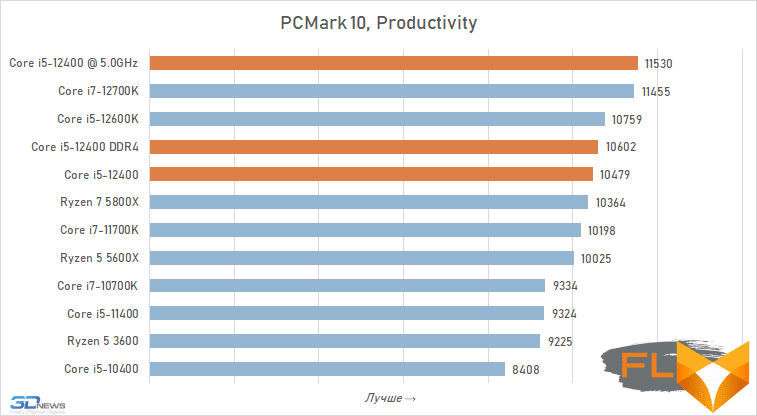
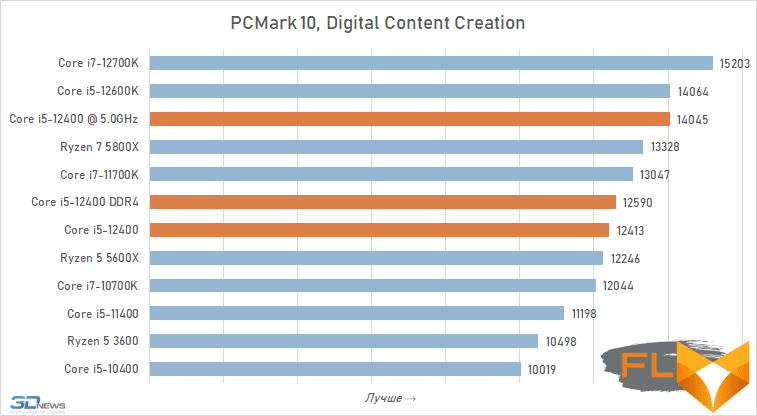
A more interesting picture of performance is drawn by the near-game 3DMark CPU Profile test. Evaluating realistic eight-thread performance, he gives the Core i5-12400 a score close to that of the Core i5-11400. As a result, the six-core Alder Lake loses in this test not only to the eight-core Ryzen 7 5800X, but also to the six-core Ryzen 5 5600X. This happens, apparently, due to the low clock speed of the Core i5-12400. At least its overclocking to 5.0 GHz corrects the situation – the performance indicator increases by almost a third and the Core i5-12400 becomes faster than any eight-core, second only to its higher-class counterparts.
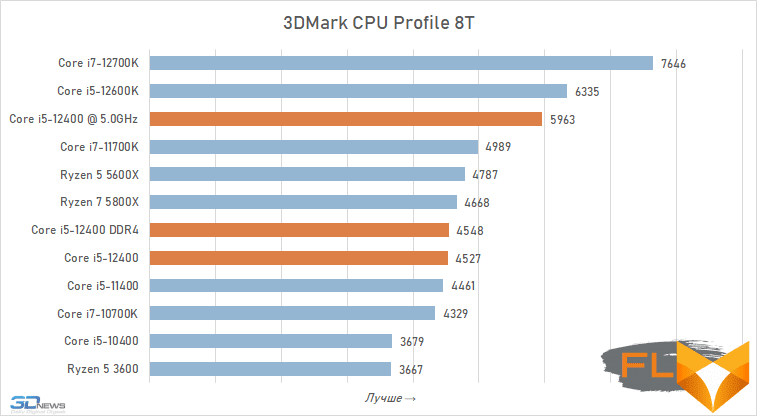
If we talk about peak multi-threaded performance in the 3DMark CPU Profile, then the situation is generally similar – the Core i5-12400 is comparable in terms of performance to the Core i5-11400 and loses to the Ryzen 5 5600X. However, overclocking in this case does not make it faster than eight cores. The five-GHz six-core Alder Lake is still inferior to both the Ryzen 7 5800X and the Core i7-11700K, leaving only the old Core i7-10700K behind.
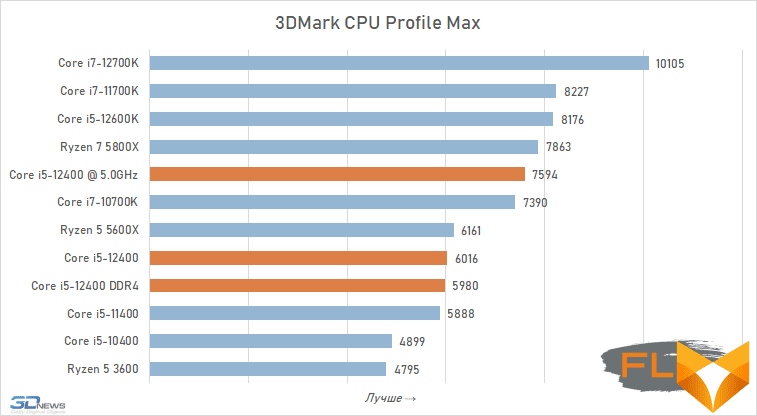
The amount of increase that is observed when overclocking the Core i5-12400 to 5.0 GHz deserves a separate comment, since it exceeds 25% – the relative increase in clock frequency. The fact is that during overclocking, in addition to increasing the frequency of computing cores, the processor receives two additional advantages. First, the frequency of the third-level cache increases. By default, the L3 cache on the Core i5-12400 runs at 3.6 GHz, but for the overclocked processor, we allowed this frequency to reach 4.0 GHz. Secondly, along with an increase in the BCLK frequency, the ASUS ROG Strix B660-F Gaming WiFi motherboard automatically enables Alder Lake support for AVX-512 instructions, which the 3DMark CPU Profile test can use in its work.
⇡#Performance in Applications
If the performance of the Core i5-12600K in resource-intensive applications could rightly be called outstanding (see the corresponding review), then the performance of the Core i5-12400 does not make such a striking impression. There is a huge gap between these processors, due to the presence of an additional four Gracemont cores in the older model, and, as tests show, they make a very significant contribution to performance. Although the Core i5-12600K and Core i5-12400 appear to be very close in terms of model numbers, in reality, the older processor in the Core i5 series is more than a third faster than the younger one. And even overclocking the Core i5-12400 to 5.0 GHz does not allow jumping over this abyss. In other words, if we talk about performance in resource-intensive tasks, then it is completely wrong to consider the Core i5-12400 as a more affordable replacement for the older Core i5.
Therefore, it should not be surprising that while the Core i5-12600K performed on a par with the eight-core Ryzen 7 5800X, the Core i5-12400 loses to the six-core Ryzen 5 5600X. There are only a few tasks where the six-core Alder Lake at the nominal frequency approaches the six-core Zen 3. Although, of course, this does not become a disaster for the Core i5-12400 – do not forget that it costs more than one and a half times cheaper, and its the real contender is not the Ryzen 5 5600X, but the Ryzen 5 3600, which hangs out on performance charts somewhere in the basement area. In other words, the Core i5-12400 is perfect for mid-range work systems. In terms of the combination of price and performance, it simply has no equal in this weight category.
In addition, do not forget about the possibility of overclocking. Increasing the frequency of the Core i5-12400 to 5.0 GHz allows you to increase its performance by about 18-20% and significantly outperform the Ryzen 5 5600X.
Rendering:
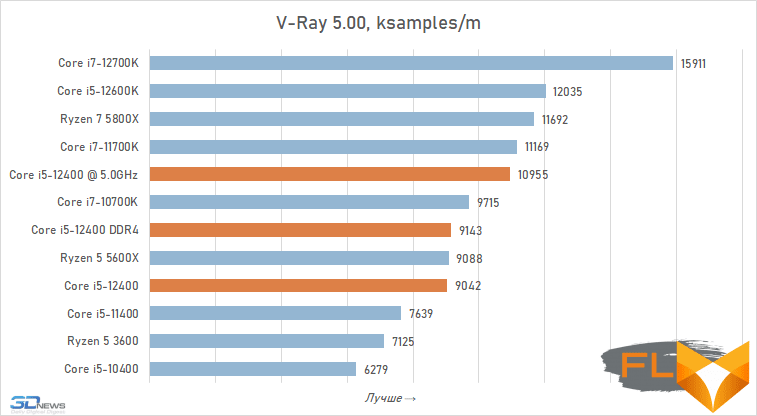
Photo processing:

Video work:
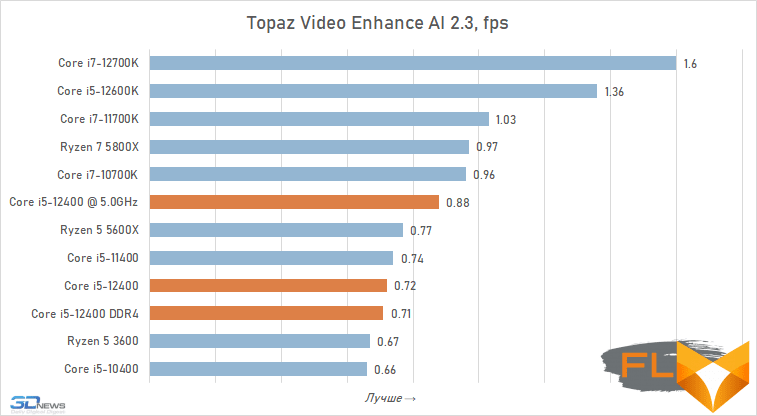
Video transcoding:
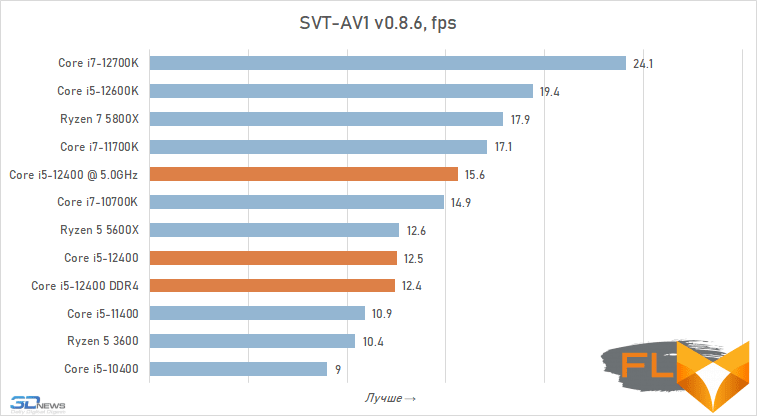
Compilation:
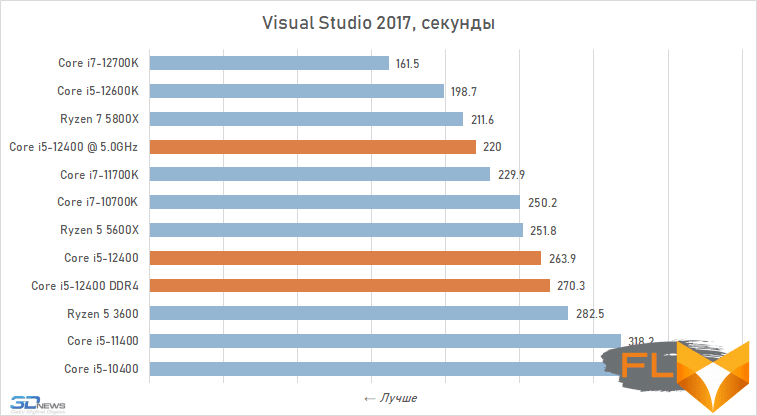
Archiving:
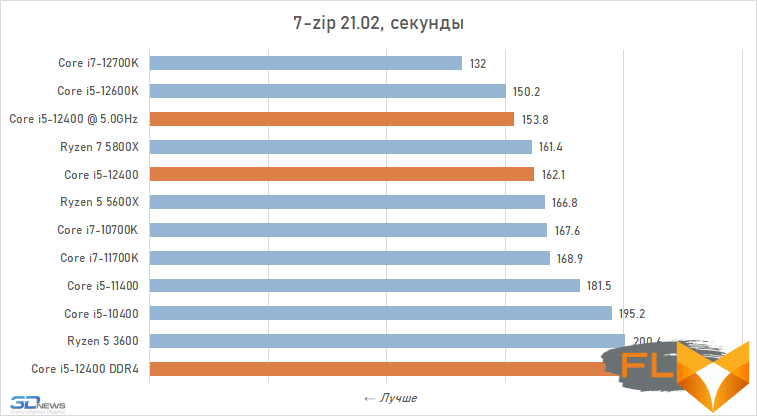
Chess:

Mathematical calculations:
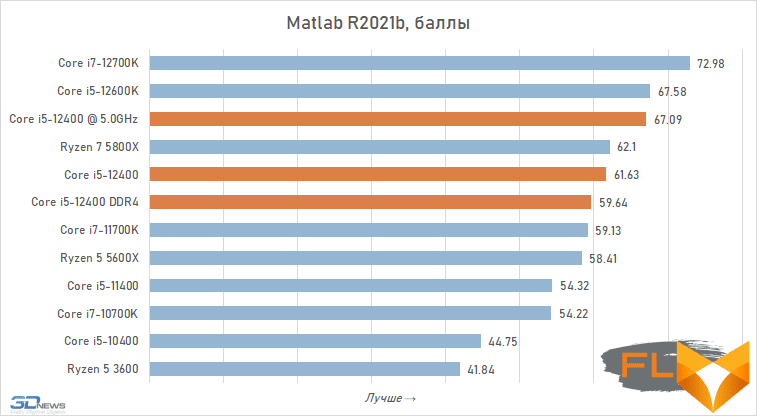
⇡#Game performance
Lower six-core processors are traditionally considered the best choice for mid-range gaming systems, and many have the same hopes for the Core i5-12400. And for good reason: this processor not only has progressive Golden Cove cores with higher specific performance compared to Zen 3 and Cypress Cove, but also has a capacious 18 MB L3 cache, not to mention support for high-speed DDR5 SDRAM. All this together provides a 12 percent superiority of the Core i5-12400 in average FPS over the Core i5-11400, which is confirmed by the results of performance measurements in 12 games.
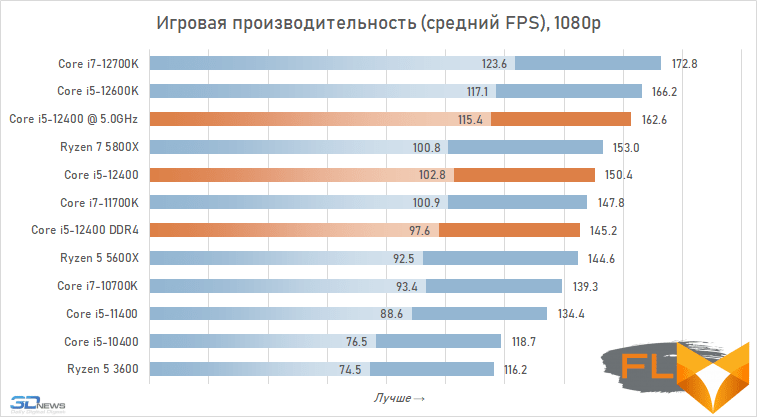
Thanks to this progress, the gaming performance of the Core i5-12400 was about the same as that of the octa-core Core i7-11700K and Ryzen 7 5800X. In other words, the younger six-core Alder Lake once again confirms the thesis that the LGA1700 is the best gaming platform at the moment.
However, it needs to be said that modern, higher-end Intel processors such as the Core i5-12600K and Core i7-12700K provide better gaming performance. For example, the same Core i5-12600K outperforms the Core i5-12400 in average frame rate by about 11%. But the younger six-core almost manages to overcome this gap by overclocking to 5.0 GHz – its average result is very close to the FPS of the ten-core Core i5-12600K.

The situation in different games may vary, but be that as it may, the Core i5-12400 in 9 games out of 12 shows better performance than the Ryzen 5 5600X, and in 6 games out of 12 – than the Ryzen 7 5800X.
At the same time, it is impossible not to notice that the Core i5-12400 overclocked to 5.0 GHz manages to bypass the Core i5-12600K in most games, which looks like another confirmation of the sufficiency of six processing cores for modern gaming systems.
⇡#Conclusions
We are talking about the fifth time that the junior representative in the Core i5 series is an excellent option for a mid-range computer. Since 2017, when the Core i5 series became six-core, Intel processors with model numbers ending in 400 have consistently become attractive deals in the sub-$200 price category. Exactly the same can be repeated with respect to the Alder Lake generation Core i5-12400 – it decisively raises the performance bar in its weight category and overshadows not only “classmates”, but also one and a half times more expensive competing solutions. This is especially evident in games, which makes the Core i5-12400 the best gaming processor from the “cheap and cheerful” category.
Given the brilliant performance of the Core i5-12600K, we certainly would like to see additional E-cores in the Core i5-12400, which could seriously increase performance in resource-intensive applications. But even without them, remaining a traditional six-core processor, the Core i5-12400 offers a noticeable progress against its predecessors. It received progressive Golden Cove cores, increased cache memory and support for DDR5 SDRAM, and in total this made it faster than the Core i5-11400 by an average of 12-13% both in applications and in games.
In addition to this, the Core i5-12400 has another plus – it can now be overclocked. And we are not talking about a homeopathic procedure with a barely noticeable effect, but about a real “old-mode” overclocking by 25% in frequency with a proportional increase in performance in sensitive tasks. Here, however, it is necessary to make a reservation that such overclocking does not work on all motherboards, but this is unlikely to stop true enthusiasts interested in obtaining additional performance.
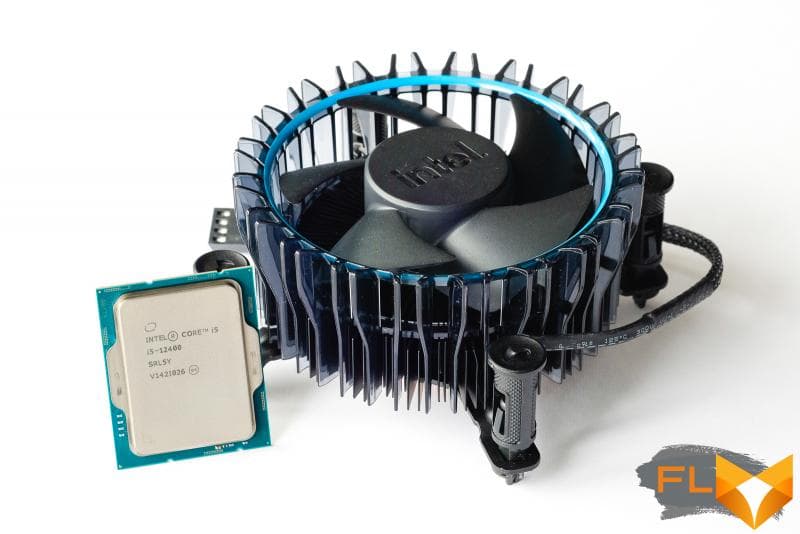
And of course, summing up, one cannot ignore the phenomenal efficiency of the Core i5-12400. Thanks to the new Intel 7 process technology, this processor not only consumes noticeably less than its predecessors, it is cooler and more economical than AMD’s current six-core processors. And this means that the Core i5-12400 does not need any motherboards with powerful power converters, or any special cooling systems. It feels great with a boxed cooler and can run even H610 motherboards with simple VRM layouts without issue. As practice has shown, with the heaviest multi-threaded load, the consumption of the Core i5-12400 does not go beyond 75-80 W, which means that the inclusion of the 65-watt PL1 limit will not lead to any noticeable decrease in performance.
The only slight complaint that can be made against the Core i5-12400 concerns the UHD Graphics 730 graphics core – it is slower than the base UHD Graphics 770 variant found in the more expensive Alder Lake. However, this nuance hardly matters, since the gaming performance of any GPU options built into Intel desktop processors cannot be described as satisfactory. In addition, if necessary, the UHD Graphics 770 graphics core is available in the Core i5-12500 processor, which is only $10 more expensive than the Core i5-12400 reviewed.
In any case, the Core i5-12400 appears to be a worthy member of the 12th Gen Core lineup. It, like other Alder Lake, can be safely recommended for current PCs – there are simply no more interesting options for inexpensive gaming systems on the market right now.
